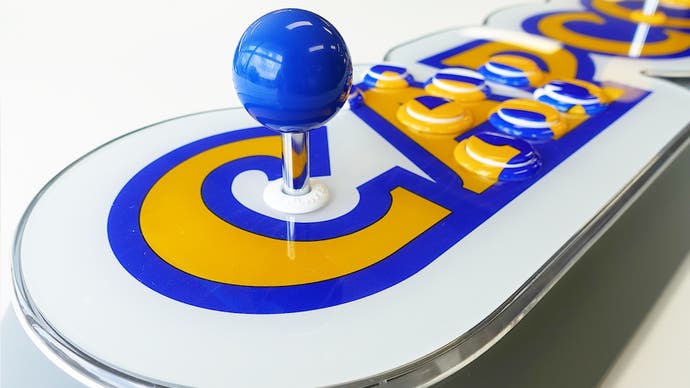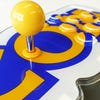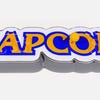Hands on with the Capcom Home Arcade
The arcade golden era in the living room?
With the rise of miniaturised retro consoles, there's still a special corner of gaming's past that's gone sorely overlooked. It's a corner that could once be found in a mid-90s London Trocadero - a space, among many spaces, that Capcom called home with its sublime arcade produce, built on the CPS1 and CPS2 boards. Between the co-op thrills of Progear and Aliens vs Predator, some of the best 2D sprite-based titles of the era sparked from this hardware, and often, their technical quality didn't translate exactly to PlayStation or Saturn, if ports were produced at all.
All of which makes Capcom's catalogue a fascinating trove of hidden gems - and the focus for the upcoming Capcom Home Arcade - a full arcade controller that aims to put this slice of gaming history in the living room. The idea is simple enough: hot off the heels of its work on the Commodore 64 mini, Koch Media has put together a Capcom-licensed plug-and-play arcade unit that comes with 16 pre-installed titles. From the iconic brawling of Final Fight, to lesser-known highlights like Capcom Sports Club, the aim is to recreate the full CPS1 and 2 arcade experience at home. With a price tag of £199 (or around $260) though, there is the expectation of a premium product. From what I've seen in an early hands-on, there's a lot going right at a design level - at the very least, focusing on the hardware.
Out of the box you get a hefty arcade unit that supports two players on one slab, and a micro USB power cable to juice it. Once the power button's pressed, video is pushed out at 1920x1080 via an HDMI port at the rear. On the whole, it's a ruggedly built bit of hardware. The fact that it sports two octagonal gate joysticks, and six quality Sanwa buttons per side also goes a long way in explaining its price tag. Impossible to ignore is that bold CAPCOM logo screaming across its top, too, a yellow and blue toned title with detailing extending to its sides in a grey, 3D mould etching. For my tastes, it's a likeable enough design - though given it's the only style on offer at launch, anyone less keen may be out of luck.
Regardless of the design, the controls on top are spot on. Anyone familiar with top-end Sanwa arcade parts will know the sense of a lightest touch triggering an input. It's precise, holds up to hard mashing and nothing jams. Equally, the spacing between the two player sides is essentially a match for a proper arcade unit (though I didn't have time to get the ruler out on this). One downside? To keep the front façade clean, and avoid labels, the start and 'insert credit' buttons near the top are tricky to tell apart - but at least the box includes stickers to help get you started.
Arguably, fans of Street Fighter 2: Hyper Fighting would have preferred a square gate joystick instead of octagonal here. The choice makes sense though - it aims to address the range of genres covered between the 16 games. Side-scrolling beat-em-ups, platformers, and shooters all have to factor in. That being said, the screws on the underside of the unit are easy to spot, where the potential for some DIY switching of parts is there.
What of the games then? Much of this boils down to the quality of emulation, which is driven by an ARM processor. I had time to play all 16 titles, each navigable through a scrolling, front-end with crisp PNG title cards, as supplied by Capcom. This default view is all we have for now, but the inclusion of a WiFi module opens up the gates to more possibilities in the future. More games is high on the wish list, of course - notably the Street Fighter Alpha series, or X-Men vs Street Fighter, or even pushing the board to CPS3 classics. The online aspect does serve a function in the here and now, however: it's put to work on active leaderboards attached to each game.
The 16 titles, at least in this early stage, look and play well. Latency is low - which is key. The exact measurements are something I've yet to take this early at, but every button input gives a perceptibly sharp response on-screen. Even hooked up to an Ultra HDTV with lag of its own, shoot-em-ups like Gigawing and 1944: The Loop Master give a satisfying snap to every button press and there's no visible delay to quarter-circle moves in Street Fighter 2 or Darkstalkers either.
Capcom's signature high resolution, CPS2-driven sprites are beautifully handled too. A true visual highlight for me is Cyberbots. Along with Alien vs Predator, it's pushing some of the more vibrant, and larger 2D character designs on the system. With the rush of enemies and excess of explosion sprites, it remains one of the best showcases for what arcades could push at the time, compared to 32-bit home console rivals. Its gameplay might not be as iconic as the likes of Ghouls and Ghosts or Strider - also included on the system - but it's great to see lesser-known titles make a cameo.
There's a reason these games resolve so well, even to a 1080p screen. The native 384x224 of CPS1 and 2 titles scale quite evenly up to the 1920x1080 of today's HDTVs. Indeed if we're to assume these are square pixels (far from the case on arcade CRTs), this scales by five times on each axis to 1920x1120 - close enough to 1080p that the results appear crisp. In other words, there's a 'wide' mode that fills out a 16:9 1080p screen out with great results. The catch? These games are of course meant to be forced to a 4:3 aspect ratio; anything else stretches the image horizontally, turning circles into ovals. To address this, a 'full' 4:3 aspect ratio mode is included, adding borders to either side to give the true proportions. Either way, we're covered.
Currently, 1080p output is the extent of the video options. We have these two aspect ratios, and a basic blur filter too - which is too aggressive to recommend. A CRT filter isn't a feature of the early unit I tried, either - but, arguably, an easy addition for a future update. Given its inclusion in the Commodore 64 mini, the team at Koch seem to be aware of its worth, and hopefully there's scope to add it in down the line. Fingers crossed.
Performance is an interesting point. Clock speeds are simulated at an emulation level to match the CPS1 and 2 boards. In the case of games like Gigawing, that means you get authentic frame-rate drops, matching those in the original. The resulting slowdown when things get really hectic is part and parcel with the game design. Indeed, bullet-hell shooters could overload the screen with sprites, but having gameplay speed drop at peak load acts almost like an aid - freeing up time to work through the maelstrom. Thankfully, it is properly simulated and so the game flows as it should.
With this being said, I did notice some gameplay skips at an emulation level. It's worth stressing it's an early unit, but a small handful of titles need tweaking, notably the shoot-em-up Eco Fighters. Frames skip and jump the gameplay ahead, disrupting control - though bizarrely it only flared up in these few, less overtly taxing games. Equally, a delay in audio output was noticed on most games, but I'm told this should be fixable. It's early days; looking at the already solid performance of Cyberbots, it stands to reason these rough spots should be ironed out before its October 25th launch.
The unit as a whole looks promising, but there has been some controversy surrounding the exact nature of Capcom Home Arcade's emulator, which has some unfortunate baggage. When it was announced in April, Koch Media's website stated that it's using FB Alpha, a well-respected CPS1 and 2 emulator. One of its programmers, Barry Harris, even tweeted that it had been licensed by Capcom itself. However, following an online backlash to its usage here - with those within the emulation community complaining it features their work - Koch Media has since removed mention of FB Alpha entirely from its front page. Instead, it now simply mentions the project has the full support of Barry Harris, but little detail on the emulator. I emailed the Koch Media team for more detail on what's going on, and they replied:
"The software of the Capcom Home Arcade is at its core made up of a Linux base (mainline kernal 5.0). This controls low level interaction with the hardware (video, sound, USB, WiFi, power drivers). The UI is a custom interface, built on top of the open source Linux graphics toolkit (SDL). When a user selects a game to play from the UI a default version of RetroArch activates and it sets some configs for our hardware and software and then executes game emulation to run.
"The emulator software is provided by Barry Harris. Barry provided bespoke emulation for the Capcom Home Arcade based on our hardware and software specification with the objective of the 16 licensed Capcom games playing as authentically as they can. The emulation includes cps2_crypt, Z80 and ym2151 software used under the relevant OSS license. An example of a feature we requested to be included in emulation was an instruction to bypass all the games splash screens on boot[...], so that the user goes straight to the games title screen once they've selected a game from the UI."
Based on this response, there's clearly a concerted push from Koch Media to distance itself from FB Alpha - but it's not clear how much has changed under the hood. The fact that the emulator's not mentioned by name at all does suggest it's still a sensitive topic. We'll have a better understanding of what's going on once we near its launch.
All told, and putting the emulation controversy aside for now, the Capcom Home Arcade is an enticing project with a lot of promise. The potential for an all-in-one CPS1/CPS2 machine is immense and at a hardware level it's very confidently built. In terms of the software, there's still some tweaking to do, though it's already in a good place for the bulk of its supported games. The controls are low latency and its visuals scale beautifully. For the rest - for the needs and wants of the retro community - having the WiFI module included will hopefully play a key role in future-proofing. It's hard to not be intrigued by the idea of revisiting a part of Capcom's history. If handled properly, having its finest arcade works brought home like this could be a revelation.









